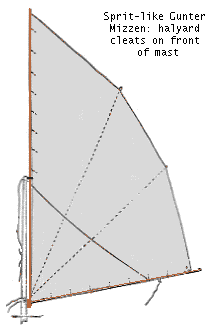 Simple
Batwing Gunter from Practical Canoeing, Chapter
V.
Simple
Batwing Gunter from Practical Canoeing, Chapter
V.
This one is an excellent and easy to make rig for casual
sailing in a canoe: note the small sail areas.
"The next Illustration is of the
Batswing Sliding Gunter, which was described as follows in a
recent number of the Field by Mr. C. Penrose, R.C.C. It is
a pretty rig, but cannot be readily taken off the mast; however,
it is easy, by lowering the mast, to stow the whole rig away
altogether. The length of the whole affair, allowing 4 inches from
boom to deck and 11 inches housing of mast, will be 8 feet 3
inches over all.... Its area without the battens would be about 35
feet in mainsail and 8-1/2 in mizen.
[Quoting Mr. Penrose]:
'This rig has stood the test of eight or nine years,
and combines to a great extent the good qualities of the
sprit-sail with those of the lug. I believe it was brought out
by Patrick, the well-known and successful boat builder and
boat-sailer, of Lincoln. About the second or third suit of
these sails was made for my first sailing canoe in 1876; and,
after hard usage and little care, only required a little
mending at the corners and eyelets to be nearly equal to new in
1882.
'The rig consists of an ordinary sliding gunter mast and
topmast, or, as some prefer to call it, gaff, carrying a
sail of elliptical form, containing nearly 1/4 more area than a
triangle of the same height and base. There should be a batten
at each reef, of which there may be two or three, and one or
more battens in the head dividing the leach equally.
'A downhaul should be fitted to the gunter brass and another
to each reef; or of course 'patent' reefing gear may be fitted,
which will act better with this rig than with the lug, because
the gear has not the strain of peaking the yard. When the
gunter brass has been lowered, the boom may be topped up to the
mast, which for light airs is sufficiently snug, but in
stronger winds something further is required.

'I have tried several dodges for lowering the "gaff" cutter
fashion upon the boom with more or less success but probably
the handiest plan is to lower the mast and all. When lowered,
the masthead will fall right in front of the canoeist, and, by
taking off the collar which holds [the] forestay
[to the masthead] the mast can be drawn aft and stowed
below, leaving nothing on deck but the stay, and can be set up
while afloat with equal ease. The heel of [the] mast
must of course be made to pull out of the tabernacle when
lowered.
'In the drawing, the rig is shown with two reefs, besides
which a balance reef may be made by lacing the third batten to
the boom. The mizen is something like Mr. Tredwen's
sprit-mizen, but has two battens instead of one, to look
more in keeping with the mainsail. With this mizen stepped
forward and a small storm-mizen aft, the canoe will sail in
almost any wind; and mine has repeatedly sailed in ease and
comfort when the local sailing boats were capsizing in all
directions. The dimensions of the sails in the drawing, as
fitted to a 16-feet canoe, are nearly the same as carried in
the 14-feet canoe rigged with them in 1876, the difference
being that the old rig had one more reef and one more batten in
the head.
'The dimensions are:
'When lowered and brailed up it can be
removed from the boat as easily as an umbrella, can be stowed
below all ready for setting again, instead of having to be
unhooked and untoggled from a lot of fastenings. Also it is
short enough to travel easily in a railway carriage, instead of
requiring the largest size of van, or having to be lashed
outside the train, as has happened now and then with the
long-masted lugsails common in the Royal Canoe Club.
'The advantage of being free from all top hamper is very
great, especially if sea sailing is indulged in, while the
power of stowing the sails below leaves the canoeist only
one thing to attend to, house, &c., viz., the canoe,
instead of two, viz., canoe and sails.
'This makes no little difference when the canoe has to be
housed in strange quarters or in a crowded boathouse. While the
lugsail canoeist is 'setting' his delicate and complicated
gear, ashore, perhaps in difficulties in finding a spot for the
purpose, secure from waves or from barge's bow lines; the
gunter sailer can put his boat in the water as if she were a
paddling Rob Roy and set his gear up at anchor or as she
drifts with the tide.
'I do not think this rig would suit very large areas or be
good for racing against lugs, but for all round work in light
and narrow canoes, I know nothing to equal it for ease in
working, safety and lightness. The appearance is good and the
falls of the lines on deck are shorter than with any other
rig.'
Figure A shows the rig raised in all its glory. a is
the Mast.
b is the sliding Upper Mast.
c is the Boom.
d is the Sprit.
e is the Topping Lift or Brail.
f is the Hoop around the mast.
g is the Gunter Iron itself.
w is the - well, I'm not quite sure what w represents. I
think it's a mast hoop to which the boom is connected, with a
hinge pin so the boom can move vertically.
Note also the swell canoeing club burgee at the
masthead.
[More text coming]